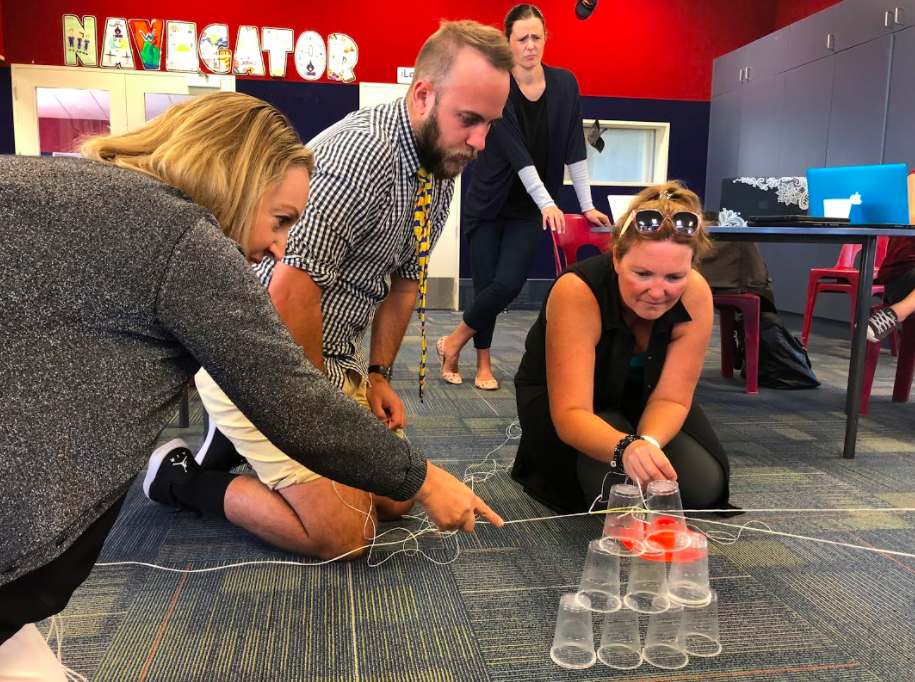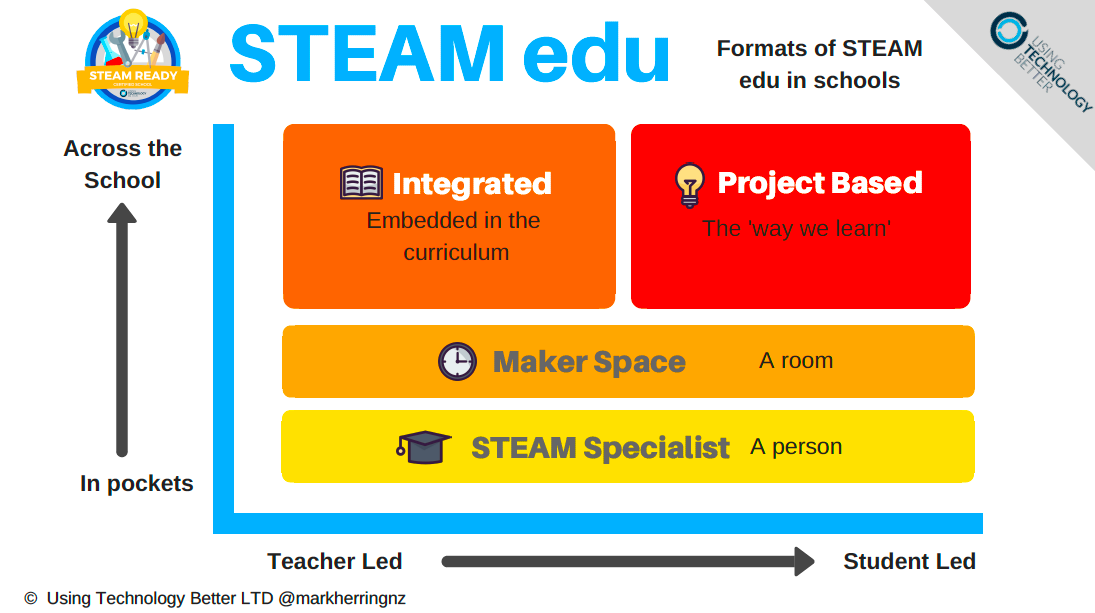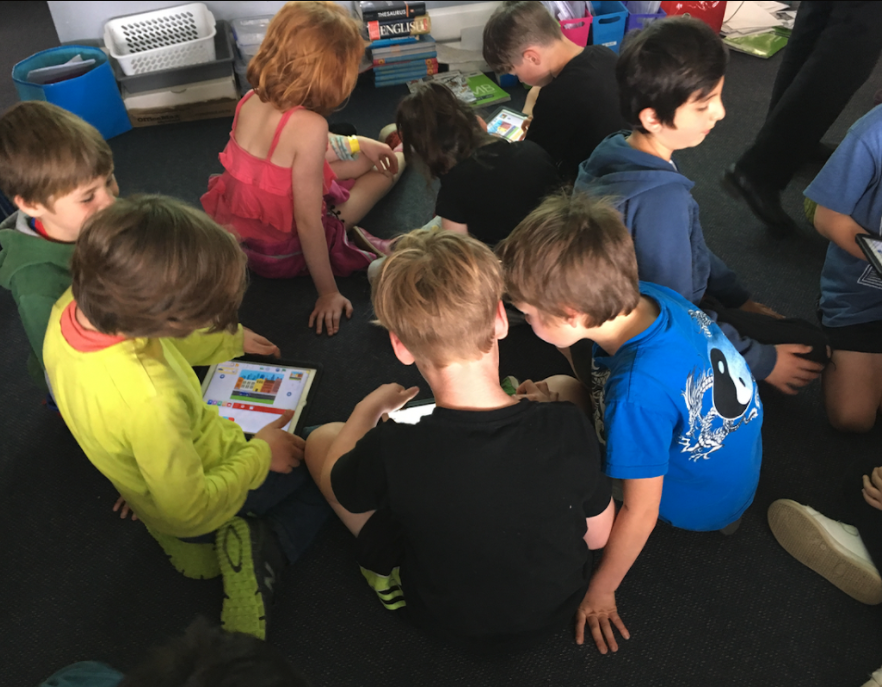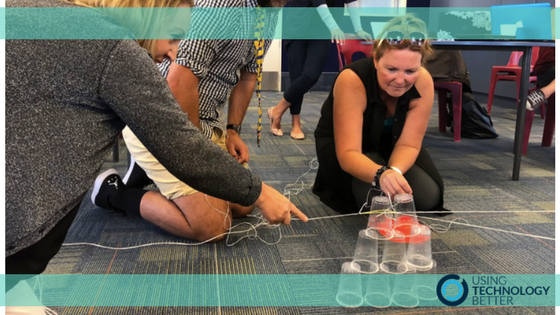
The STEAM learning approach can look incredibly different from school to school. It can vary from curriculum design to the intended outcomes, equipment used and even the physical spaces.
This can make it very difficult for schools to make decisions about where to start, or what to do next. Here are some different approaches that we see in schools, and some positives and negatives about each approach.
In this framework, along with the four approaches, we’ve illustrated how well they tend to achieve two things:
- School-wide capacity: This relates to how widespread across classrooms and teachers the STEAM learning approach has developed.
- Student agency: This is the level of choice and autonomy a student has to develop their own passions, areas of interest and solutions to authentic problems.

[bctt tweet=”Here are four different kinds of STEAM learning your school can adopt and their potential impact on student agency and school wide adoption!” username=”markherringnz”]
1.Having a STEAM Specialist
This is the most common approach we see in schools. This person usually has some expertise in the technology/design process and is tasked with running STEAM experiences for students, either in a designated space or mainstream classes while teachers are released.
Pros:
This person usually develops a high level of STEAM skills and can be a ‘go to’ person for other teachers. They also often help to keep the benefits of STEAM learning in the front of teachers minds.
Cons:
There’s a danger for schools with this approach that teachers will end up deferring any STEAM experiences to this specialist teacher. As such, a school looking for school-wide adoption ends up stifling the very progress they were trying to achieve. It’s very common for any STEAM learning to start and stop with this teacher.
2. A Maker Space
Schools looking to invest some capital or grant money will often design and build a dedicated STEAM room, often called a Maker Space. This is equipped with space, gear and a person to help students connect with STEAM projects.
Pros:
Students can get set up and engaged with STEAM very easily and usually have somewhere to store and save their projects over time. The rooms are also often designed with STEAM learning in mind; very flexible, wide desks and spaces conducive to collaborative learning.
Cons:
This approach has similar downsides to the specialist teacher approach, where the momentum for change across the school often stalls past this space. Teachers tend to feel that STEAM learning is something that happens in this space and not in their classrooms. With timetabling restraints, students can find that the STEAM experiences are restricted to a few weeks in a year or hours in a week. Click here for more about this in our post, ‘Five Myths about STEAM Learning’
3. The Integrated Approach
This is the approach where teachers will integrate STEAM into their curriculum/subject areas. They may facilitate a STEAM project to help students understand some mathematics concepts, or as a follow-up activity to a reading lesson. This is fundamentally where students are using STEAM tools, methods and collaboration to discover and deepen their understanding of mainstream curriculum learning outcomes.
Pros:
Research shows that curriculum integration leads to deeper learning for students. They’re not only more engaged, but more likely to develop higher order thinking skills. This is the essence of STEAM learning – thinking and the NPDL’s description of the 6Cs of Global Skills.
Cons:
When STEAM is driven through curriculum integration, usually the key driver of this process is the teacher. This can be a lost opportunity for developing students sense of agency (the ability to act), their independent learning skills and self-motivation. The other downside to integration beginning from a subject area focus is the danger that the project is guided by the teacher’s preconceived idea of learning outcomes. This can shape the projects in ways that hinder the design thinking process, making it more contrived and inauthentic.

[bctt tweet=”Wondered about the link between STEAM Learning and PBL? Here they are, and their benefits for learning!” username=”markherringnz”]
4. Project Based Learning
This approach, when combined with the STEAM elements of computational thinking, the Design Thinking process, and ‘electro technologies,’ is where a student’s timetable is structured around an authentic problem-based process. The learning outcomes are often mapped ‘backwards’ as an outcome, rather than a driver. There are schools where the day to day activities are centered around the student’s interests, needs and a desire to create solutions to real-world issues.
Pros:
There is research to show that PBL schools and experiences result in just as effective, if not higher, achievement rates for students, higher retention and much improved higher order thinking skills (evidence and links for this research here, at Edutopia.org). Shouldn’t the goal of every school be to improve learning outcomes and lift engagement?
Cons:
There is a huge mindset shift for teachers and administrators to achieve this style of learning across their school. There is the massive disruption of timetabling, teacher identity and roles, not to mention the commitment needed by the wider parent and business community to resourcing this approach to learning. Project Based Learning, across the school, takes a large level of commitment and implementation takes time, effort and dedication, not to mention belief.
So, which of these approaches is your school implementing at the moment, or what could your school work towards as a vision for STEAM learning with your students? You could even use this framework as a way to set some goals and some strategic planning for the years ahead.
If you’d like some assistance with this, we’d love to hear from you. We partner with schools at the leadership and teacher level with our STEAM Ready Programs. Contact us to ask for more information here about these programs
We also run STEAM Learning workshops all over Australia, New Zealand, Asia and the US. Click here to see our upcoming events, STEAM #1 or #2 workshops, or let us know if you’re interested in hosting a regional event at your school.











